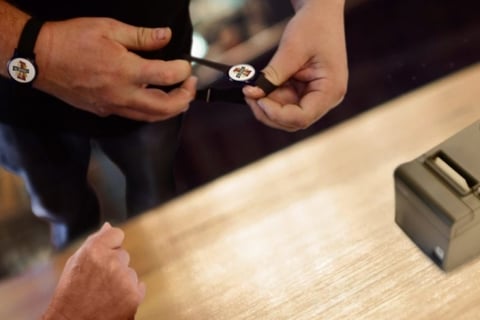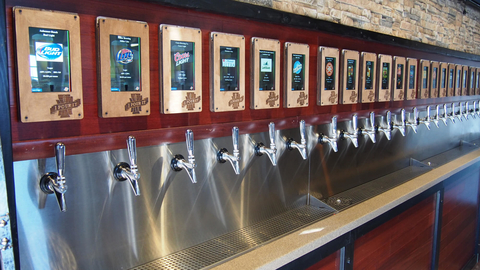It’s no secret that within the restaurant and bar industry there is a heavy focus in the off-premise sales category. One can argue that this alone is the top “disruptor” of the industry in recent memory.
While delivery and off-premise dining aren’t going to go anywhere anytime soon, operators should still look to enhance their on-premise guest experiences to encourage guests to visit their venues.
One of the ways right now to accomplish this goal is to install an engaging, on-premise, self-serving beer (or beverage) experience; an element that promotes choice, sampling, and yes—additional revenue.
With the rise of the fast casual segment over the past number of years, guests have become very familiar with the do-it-yourself or build-your-own service style.
With that in mind, why wouldn’t guests today enjoy pouring their own beer?
This is a concept, after all, that’s been tested among hundreds of venues throughout North America—with promising results.
On the surface, there are many intriguing elements of self-serve or “pour-your-own” beer walls, including better pouring yields, the collection of guest data, improved staff efficiencies, public relation opportunities, and best of all—memorable guest experiences.
How Does it Work?
If you haven’t seen this in action yet by installers such as Table Tap, iPourIt, PourMyBeer, and others, it is essentially a number of beer taps (you choose the number) lined along a wall within your venue (or right at a table), often with digital screens and card readers, available for guests to use.

Guests load a unique RFID card with up to two drinks (counted in ounces) at a time, allowing your venue to keep control of guest consumption—the same as a bartender would. The guests then walk to the wall and decide the type of beer they want, choose the number of ounces they want, scan their card, pour their beer, and are charged only for the ounces they take.
Check this out: Brew Your Own: Find Success with Your Own Brews
The fun doesn’t stop at just beer, though. These systems could dispense wine, cold-brew coffee, kombucha, and other beverages, including cocktails (pending your local serving laws).
Picture your guests coming in and trying different beverages, asking their friends which they’ve tried, and discussing the flavors of the drink. The entire experience becomes very hands-on and interactive—two ingredients to a memorable experience.
The Technologies Available
At first glance, even I—along with many other industry leaders—was skeptical when this started to become more mainstream. As someone who actively promotes the healthy consumption of drinking and guest safety, I wasn’t so sure about guests serving themselves alcohol.
Rightfully so, many operators are concerned about the legalities of self-serve alcohol. But with the advanced technologies that these systems use and the control systems available within, it is easy to see why many liquor authorities around the world are approving these self-serve concepts.
Among the competitive market of installers, the technology available also provides an algorithm that collects valuable demographic data for the operator, including gender and age.
This data, paired with other data from the point-of-sale or other apps that are compatible integrations, will provide operators with an abundance of information to immediately improve operations and their marketing efforts.
Check this out: The Importance of Beer Training For Guest Satisfaction
Furthermore, each screen above the tap can include educational information, including beverage name, beer description, brewer information, ABV, IBU, and price per ounce—all the information a guest would need to make an informed decision.
This type of technology, according to PourMyBeer.com, could increase sales by 45 percent, decrease overhead by 20 percent, increase profits by 50 percent, and reduce waste to less than 1 percent. Who wouldn’t want all that?
What About My Bartenders?
The job scope of bartending has really evolved over the past decade, and today we’re seeing a stronger focus put toward unique craft cocktails within a beverage program, and naturally so. This, too, is a key factor in encouraging guests to visit your restaurant or bar, versus requesting take-out or food for delivery (off-premise).
Unless you employ “beertenders” within your venue, a real bartender would likely enjoy crafting cocktails versus pouring beer or even a glass of wine. Installing beer walls will provide you and your bar team the opportunity to create more advanced cocktail programs.

Will a beer wall reduce labor costs? In most cases no, but bartenders will no longer need to pour beer, allowing them more time to produce high-profit cocktails and spend more time on face-to-face guest experiences while at the bar.
Pairing this together with a self-serve beer wall will, in fact, help control your labor, improve efficiencies, and increase your profit margins—in both the beer and cocktail segment of your beverage program.
Remember, with self-serve beer your customers are charged per ounce dispensed, taking on the precise cost, resulting in nearly 100-percent yield versus the often 15-20 percent potential keg loss a traditional bar sees today.
While the installation costs can vary among vendors and the size of wall or number of dispensers, the potential return on investment is going to be undoubtedly strong for you and your venue.
Check this out: Blow Shit Up: Tanisha Robinson on Crowdfunding Your Venue and Brand Expansions
Since it is also relatively new, adding this to your venue will immediately draw the attention of the public and your local media outlets, creating a public relation strategy in addition to strengthening partnerships with beer vendors due to the advanced education and advertising for them and their brand(s).
In a time where venues must be more creative, engaging, efficient, and memorable than ever before, self-serve beer makes complete sense for a variety of concepts out on the market today. It may just be time to start embracing not only technology, but the independence of self-serve beer as a key differentiator!
